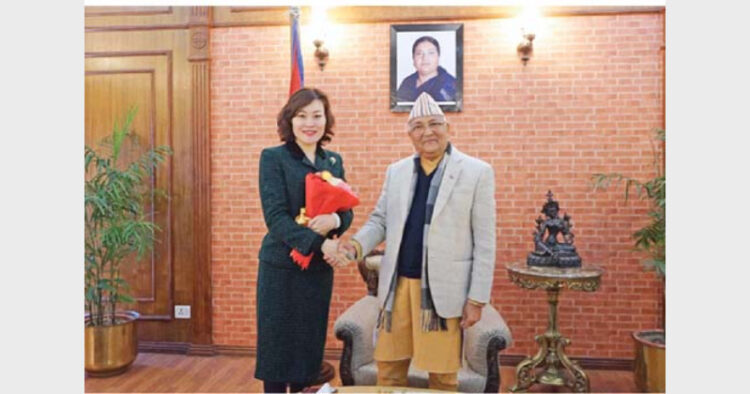China’s insatiable greed land strategy of grabbing countries in its debt trap diplomacy will turn improverished Nepal into another Pakistan
–Dr Ambikesh Kumar Tripathi

Chinese Ambassador Hou Yanqi meeting with
Nepalese Prime Minister KP Sharma Oli on January 8, 2019
Nepalese Prime Minister KP Sharma Oli on January 8, 2019
By adopting a new map of the country by Nepal’s Parliament, the relationship between India and Nepal now comes into turmoil. Nepal and India share an open border of about 1,880 km, and both the countries have finalised almost of their boundary. Still, the Lipulekh pass, Kalapani and Limpiyadhura in western Nepal are among the areas that remain disputed. Together, the three areas cover about 372 Sq. Km. The strategically crucial Lipulekh pass, a tri-junction connects the Indian state of Uttarakhand with the Tibet and Nepal, can open a door for China to enter in Nepal.
The Background
Despite the ancient tradition of shared cultural heritage, Indo-Nepal diplomatic relations began to deteriorate almost immediately after India’s Independence. In 1955, when King Mahendra came to power, by adopting the principle of equal distance, he established diplomatic relations with China. However, Nehru believed ‘‘…even a child knows that one cannot go to Nepal without passing through India. Therefore, no other country can have as intimate a relationship with Nepal as ours’’, China built a highway in 1956 from Kodari to Kathmandu, a Nepalese village adjoining Tibet border, was first Chinese diplomatic win over India in South Asian region. After the 1962 war with China, Nepal became strategically more important to India to secure its northern border.
Indo-Nepal diplomatic relations became highly hostile in the 1980s. Nepal imported arms from China without consulting India. It was a violation of the Peace and Friendship treaty of 1950. The then PM Rajiv Gandhi, instead of using diplomatic tools to bring Nepal closer, adopted hard-power and closed all routes to Nepal from India. This resulted in Nepal’s drift towards China.
Nepal’s internal politics remained in turmoil due to different stakeholders in power-politics that has affected its relations with India. Since India does not intervene in Nepalese internal politics and Nepal blames India for its instability, the confidence-building process always in crisis. After seventeen years, in August 2014 PM Modi visited Nepal to bring warmth to relations with Nepal and signed many MoUs including hydropower, irrigation and infrastructural development projects and addressed the Nepalese Parliament. PM Modi visited this Himalayan nation three times; last was in 2018 when the staunch Leftist formed government in the leadership of KP Sharma Oli, to strengthening political and economic relations with Nepal.
Issues of Dispute
There are two key issues of dispute between both countries. One is the demand for a review of ‘‘Indo-Nepal Peace and Friendship treaty’’ of 1950, a non-reciprocal treaty, although the terms are extremely beneficial for Nepal. With the Maoist uprising, the demand for a review of Peace and Friendship treaty was increased and some sections of Nepal population claim that the treaty erodes Nepalese autonomy and is an obstacle in modernising the Nepalese military. India argues that the treaty is the interest of Nepalese people that provides wider opportunities of living, business and job. Under this treaty, India gave seaport access to Nepal for imports. India is also ready to review this treaty. But it is unclear whether Nepal wants a full review of this treaty or a partial review.
Second is the Sugauli Treaty of 1816 related to Kalapani region of Uttarakhand, an Indian state. However, Nepal claims Kalapani region by saying that the region is not a part of the Nepal-India border dispute. According to Nepal, the Ka lapani region was offered to India after the 1962 India-China war by the King of Nepal, to help India’s security concerns due to perceived Chinese threats. Thus, it was Nepal’s territory that the king had allowed India to use temporarily; the region should be handed back to us. The current Nepalese map issue came from the backdrop of the Sugauli treaty. Since India was a British colony and the treaty of Sugauli is the result of the decisive victory of the British in two-year Anglo-Nepalese war, India has legitimate claim over the Kalapani region.
The China Factor
It is noteworthy here that amid COVID-19 pandemic the sudden raising of border issue by Nepal and passing of a new map of the country in the Parliament is not normal. China’s intervention behind this incident cannot be denied. China has been struggling for a long to establish itself in South Asia. Since the Kalapani region is tri-junction and strategically important for the security of India’s northern border, China wants its strong presence so that it can challenge India. Against this backdrop, China has invested in infrastructure development in Nepal.
The current Oli Government is playing to Beijing’s trap. Beijing wants to take advantage of Nepal’s geo-strategic position to trouble India and get political mileage. But Nepal should not forget that Mao’s Palm-Finger theory considers Nepal as a finger. According to Mao ‘‘the correct boundaries of China would include Burma, Bhutan and Nepal’’. He also postulated in his ‘‘Five Fingers of Tibet policy’’ that Tibet was like right palm and Ladakh, Nepal, Sikkim, Bhutan and Arunachal Pradesh the five fingers attached to that palm.
The current Oli Government is playing to Beijing’s trap. Beijing wants to take advantage of Nepal’s geo-strategic position to trouble India and get political mileage
Future Prospects
The independence and stability of Nepal lie with India. China’s expansionist policy and the vicious cycle of economic debt will ruin Nepal’s autonomy and will make Nepal instable. India’s growing position in world politics and closeness with different powers has diverted its focus from neighbours. However, PM Modi’s neighbourhood-first policy has brought some positive responses, but many have to come. As far as Nepal is concerned, its economy is falling and political instability has brought this Himalayan nation into great trouble. Like Bhutan, India has to work on electricity production in Nepal, since it has huge potential in hydroelectric. It will not only end Nepal’s dependency over India for electricity but will also be able to export. Being a landlocked country, Nepal needs to be dependent on India and being the largest country of South Asia, India needs strategic cooperation with Nepal. India respects Nepalese sovereignty and integrity, and a stable Nepal is good for India’s national interest. By the investment in infrastructure development in Nepal, India can counter China.
(The writer teaches Peace and Conflict Studies at Mahatma Gandhi Central University, Motihari, Bihar)














Comments